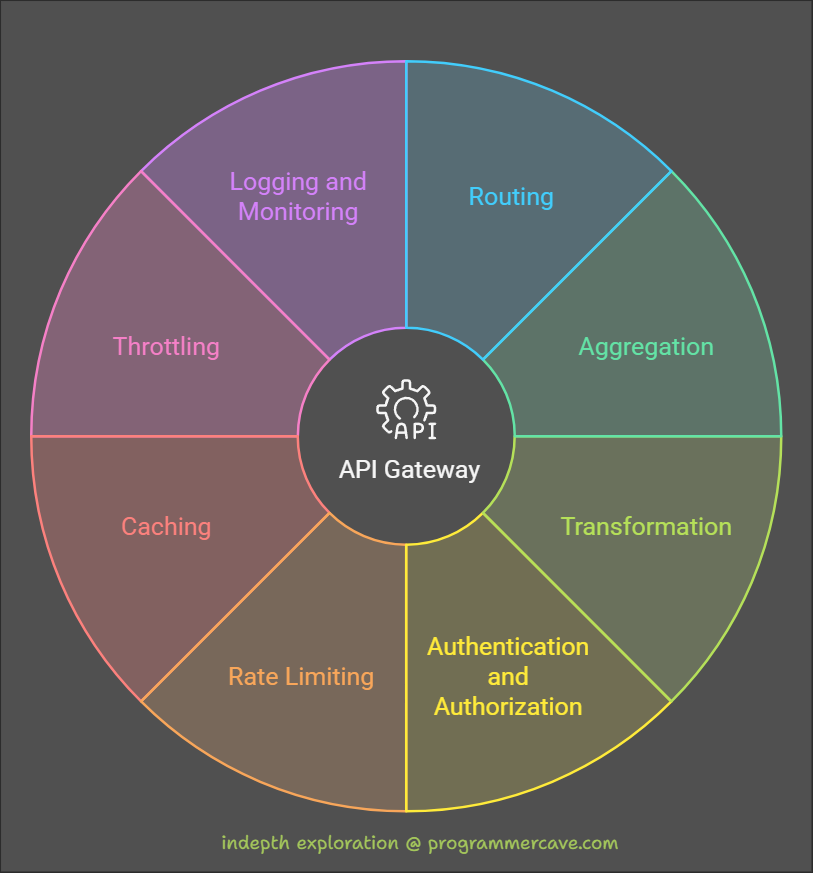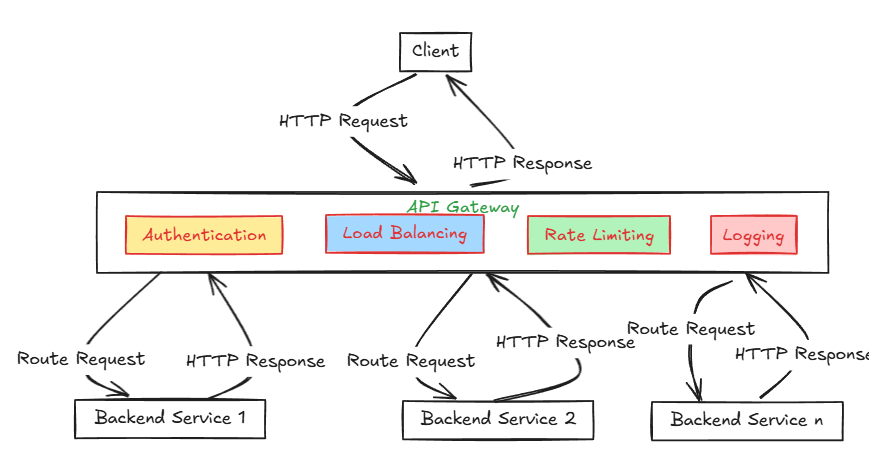Interview Question: What is an API Gateway?
What is an API Gateway?
An API Gateway is a server that acts as a single entry point for all client requests. It routes these requests to the appropriate backend services and handles responses back to the client. This centralized approach helps in managing and securing APIs efficiently, making it an essential component in modern software architecture.

Key Concepts of API Gateway
- Routing: Directing incoming requests to the correct backend service.
- Aggregation: Combining data from multiple backend services into a single response.
- Transformation: Modifying request or response formats to meet client requirements.
- Authentication and Authorization: Ensuring only authorized users can access specific APIs.
- Rate Limiting: Controlling the number of requests a client can make within a certain time frame.
- Caching: Storing frequently accessed data to reduce latency and load on backend services.
- Throttling: Limiting the rate of incoming requests to prevent overloading the system.
- Logging and Monitoring: Tracking API usage and performance for analysis and troubleshooting.
Benefits of Using an API Gateway
- Simplified Client Code: Clients only need to interact with one endpoint, reducing complexity.
- Security: Centralized handling of authentication, authorization, and rate limiting enhances security.
- Scalability: Easier to scale and manage multiple backend services.
- Flexibility: Can handle different protocols and formats (e.g., HTTP, gRPC, WebSocket).
- Performance: Caching and load balancing can improve response times.
- Maintainability: Changes to backend services do not affect the client code, making maintenance easier.
Common Use Cases
- Microservices Architecture: Managing and routing requests between multiple microservices.
- Mobile and Web Applications: Providing a unified API for different types of clients.
- Third-Party Integrations: Exposing APIs to external developers while maintaining security.
- API Management: Handling versioning, documentation, and monitoring of APIs.
Diagrams
Basic API Gateway Architecture

Interview Questions and Answers
-
What is the primary role of an API Gateway?
- The primary role of an API Gateway is to act as a single entry point for all client requests, routing them to the appropriate backend services, and handling responses back to the client.
-
How does an API Gateway improve security?
- An API Gateway improves security by centralizing authentication, authorization, and rate limiting. It ensures that only authorized users can access specific APIs and limits the number of requests to prevent abuse.
-
Can you explain the concept of API aggregation?
- API aggregation involves combining data from multiple backend services into a single response. This reduces the number of requests clients need to make and simplifies the client code.
-
What is rate limiting, and why is it important?
- Rate limiting is the process of controlling the number of requests a client can make within a certain time frame. It is important to prevent overloading the system and ensure fair usage of resources.
-
How does caching work in an API Gateway?
- Caching in an API Gateway involves storing frequently accessed data to reduce latency and load on backend services. When a client makes a request, the gateway first checks if the data is available in the cache before forwarding the request to the backend.
-
What are some popular API Gateway solutions?
- Some popular API Gateway solutions include Kong, Apigee, AWS API Gateway, and Microsoft Azure API Management.
-
How does an API Gateway handle different protocols and formats?
- An API Gateway can handle different protocols and formats by transforming requests and responses as needed. For example, it can convert a JSON request to a gRPC request or vice versa.
-
What is API versioning, and how is it managed in an API Gateway?
- API versioning is the practice of maintaining multiple versions of an API to support backward compatibility. In an API Gateway, versioning can be managed by using different paths (e.g.,
/v1/,/v2/) or headers to route requests to the appropriate version of the backend service.
- API versioning is the practice of maintaining multiple versions of an API to support backward compatibility. In an API Gateway, versioning can be managed by using different paths (e.g.,
Additional Tips
- Practice with Real Examples: Try setting up a simple API Gateway using a tool like Kong or AWS API Gateway.
- Understand the Tools: Be familiar with the tools and technologies commonly used in API Gateway implementations.
- Stay Updated: Keep up with the latest trends and best practices in API management.
Conclusion
Understanding the role and capabilities of an API Gateway is crucial for any Software Engineer, especially those preparing for interviews. By mastering the key concepts, benefits, and use cases, you can confidently discuss and implement API Gateways in your projects. Good luck with your interview!